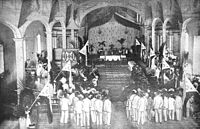In 1781, Governor-General José Basco y Vargas established the Economic Society of the Friends of the Country.[37] The Philippines was administered from the Viceroyalty of New Spain until the grant of independence to Mexico in 1821 necessitated the direct rule from Spain of the Philippines from that year. Developments in and out of the country helped to bring new ideas to the Philippines including the ideals of the French and American Revolutions. In 1863, Queen Isabella of Spain decreed the establishment of a public school system in Spanish, leading to increasing numbers of educated Filipinos. The opening of the Suez Canal in 1869 cut travel time to Spain. Both of these events prompted the rise of the ilustrados, an enlightened class of Creoles and Indios, since many young Filipinos were able to study in Europe.
The first official census in the Philippines was carried out in 1878. The country's population as of December 31, 1877 was recorded at 5,567,685 persons.[38]
Enlightened by the Propaganda Movement to the injustices of the Spanish colonial government and the "frailocracy", the ilustrados originally clamored for adequate representation to the Spanish Cortes and later for independence. José Rizal, the most celebrated intellectual and radical illustrado of the era, wrote the novels "Noli Me Tangere", and "El filibusterismo", which greatly inspired the movement for independence.[39] The Katipunan, a secret society whose primary purpose was that of overthrowing Spanish rule in the Philippines, was founded by Andrés Bonifacio who became its Supremo (leader).
The Philippine Revolution began in 1896. Rizal was implicated in the outbreak of the revolution and executed for treason in 1896. The Katipunan in Cavite split into two groups, Magdiwang, led by Mariano Álvarez (a relative of Bonifacio's by marriage), and Magdalo, led by Emilio Aguinaldo. Leadership conflicts between Bonifacio and Aguinaldo culminated in the execution or assassination of the former by the latter's soldiers. Aguinaldo agreed to a truce with the Pact of Biak-na-Bato and Aguinaldo and his fellow revolutionaries were exiled to Hong Kong. Not all the revolutionary generals complied with the agreement. One, General Francisco Makabulos, established a Central Executive Committee to serve as the interim government until a more suitable one was created. Armed conflicts resumed, this time coming from almost every province in Spanish-governed Philippines.
In 1898, as conflicts continued in the Philippines, the USS Maine, having been sent to Cuba because of U.S. concerns for the safety of its citizens during an ongoing Cuban revolution, exploded and sank in Havana harbor. This event precipitated the Spanish-American war.[40] After Commodore George Dewey defeated the Spanish squadron at Manila, the U.S. invited Aguinaldo to return to the Philippines, which he did on May 19, 1898, in the hope he would rally Filipinos against the Spanish colonial government. By the time U.S. land forces had arrived, the Filipinos had taken control of the entire island of Luzon, except for the walled city of Intramuros. On June 12, 1898, Aguinaldo declared the independence of the Philippines in Kawit, Cavite, establishing the First Philippine Republic under Asia's first democratic constitution.[39]
Simultaneously, a German squadron arrived in Manila and declared that if the United States did not seize the Philippines as a colonial possession, Germany would. In the Battle of Manila, the United States captured the city from the Spanish. This battle marked an end of Filipino-American collaboration, as Filipino forces were prevented from entering the captured city of Manila, an action deeply resented by the Filipinos.[41] Spain and the United States sent commissioners to Paris to draw up the terms of the Treaty of Paris which ended the Spanish-American War. The Filipino representative, Felipe Agoncillo, was excluded from sessions as the revolutionary government was not recognized by the family of nations.[41] Although there was substantial domestic opposition, the United States decided neither to return the Philippines to Spain, nor to allow Germany to annex the Philippines. In addition to Guam and Puerto Rico, Spain was forced in the negotiations to hand over the Philippines to the U.S. in exchange for US$20,000,000.00,[42] which U.S. characterized as "... a gift from the gods."[43][44] The first Philippine Republic rebelled against the U.S. occupation, resulting in the Philippine-American War (1899–1913).


No comments:
Post a Comment